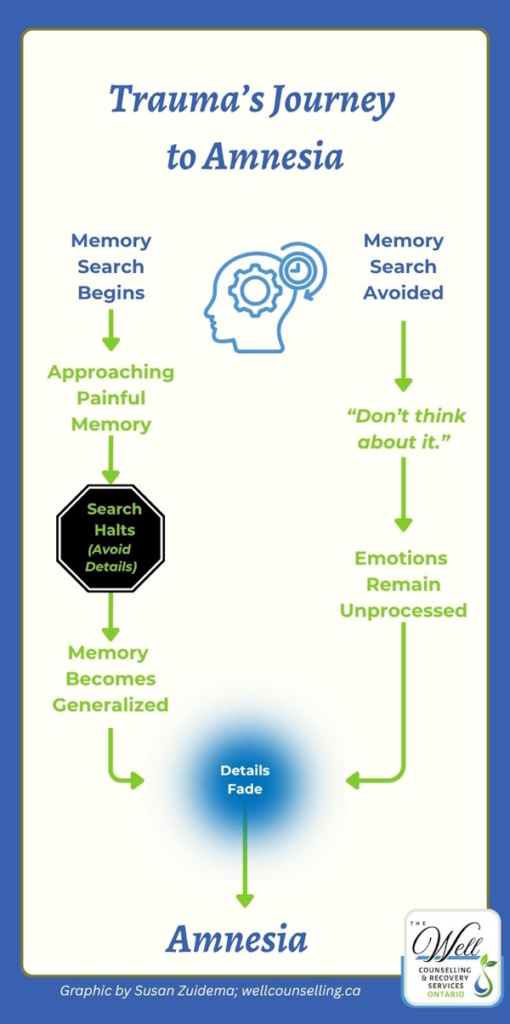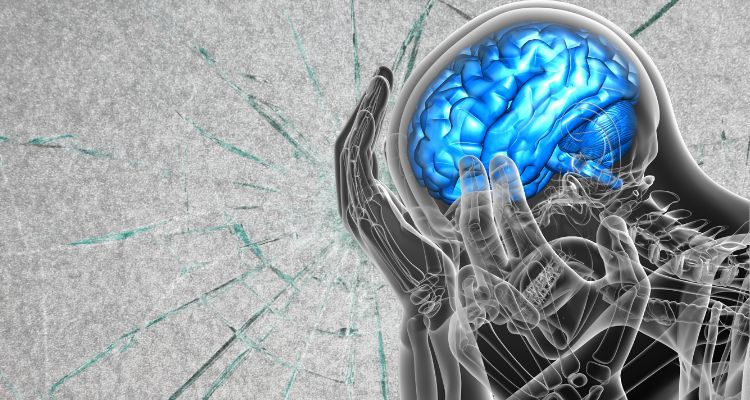The Trauma Symptom of Amnesia: “I don’t remember my childhood”
Amnesia can be a confusing and distressing experience for people living with post-traumatic stress disorder (PTSD). It often shows up in those who dissociated during abuse, meaning their minds disconnected from what was happening as self-preservation. This can result in people being unable to remember traumatic events, or even large parts of their childhood.
Everyone has a period of “childhood amnesia” – usually most of what happens before the age of three is completely forgotten. Adults without a history of trauma can usually remember visual memories – mainly positive ones – starting at 3 ½ and verbal memories after the age of 4. Negative memories begin to be stored later. However, when someone has experienced sexual, physical, or emotional childhood abuse, memories often begin much later.[i] People can also forget specific memories that happen after the period of childhood amnesia. This means that when I hear clients state, “I can’t remember much of anything from my childhood,” this can be an indicator of trauma.
How does this amnesia develop? Often, it’s because people avoid painful memories. Our brains tend to search for memories from the top down—starting with general information and moving to details. But when the brain gets close to a memory involving trauma, it may stop the search and generalize instead to avoid the pain. Over time, this can cause the detailed memory to disappear. Also, when people try not to think about something on purpose, it can prevent them from processing the emotions tied to the memory.[ii] Sexual trauma is most likely to bring on a period of amnesia, followed by emotional and physical traumas [iii].
The experience of betrayal during traumatic abuse can also result in the development of amnesia. If the abuser is the child’s father, betrayal is automatically high, and amnesia is three times as likely. That’s because the child depends on their abuser for nurture and support so their brain may block out the abuse and hold onto more supportive moments. This allows the child to continue to interact quite normally with their abuser.[iv]
A double betrayal can occur if the child discloses to a trusted adult such as a teacher or their mother and receives a negative response, leading to a higher likelihood of amnesia. The child may feel hopeless, like there’s no point in remembering what happened because nothing will ever change.[v] One study found that only 25% of children told someone about their abuse while it was happening and that more than half were not believed or blamed. In half the cases, this led to amnesia. However, when a child receives emotional support and the abuse is stopped, memory loss is much less likely. In that particular study, none of the children who received a helpful response later developed amnesia.[vi]
Dissociation is a specific way the brain handles trauma, and it can lead to a type of memory loss called dissociative amnesia. This means a person can’t remember key parts of a traumatic event, or sometimes entire time periods, or even who they are.[vii] Children may describe their memories as vague pieces rather than as full stories.
There is no guarantee that people with trauma-induced amnesia will regain their memories, but memories can return. Many things can trigger this, e.g., flashbacks or nightmares (25%), things a survivor hears or reads (21%), reminders of the trauma (15%), therapy (14%), things they see (13%), sexual contact (12%), someone telling them about it (10%) or in other ways such as childbirth.[viii]
A client may come to therapy because they suspect trauma-related amnesia and are launching a journey of trying to recover parts of their past. Doing this within a safe environment such as therapy can help a client to heal as memories resurface. In these situations, I use Emotionally-Focused Individual Therapy (EFIT). This model acknowledges that trauma memories often remain “stuck” because they haven’t been fully experienced or integrated. EFIT accesses the primary emotions tied to those memories—often grief, fear, shame—and follows them through to completion so they can be released and re-integrated. This is done within the safety of a relationship with a trusted therapist, who is trained to monitor and manage a client’s ability to tolerate the process of therapy so that the process is gentle and manageable.
If you can’t remember much of your childhood and want to talk about it, let’s connect.

Endnotes
[i] R. Joseph, “Emotional Trauma and Childhood Amnesia,” Consciousness & Emotion 4, no. 2 (2003): 151–79, https://doi.org/10.1075/ce.4.2.02jos.
[ii] Sabine Schonfeld et al., “Overgeneral Memory and Suppression of Trauma Memories in Post-Traumatic Stress Disorder,” Psychology Press, Memory, 15, no. 3 (2007): 341, https://doi.org/10.1080/09658210701256571.
[iii] Colin A. Ross et al., “Reversal of Amnesia for Trauma in a Sample of Psychiatric Inpatients with Dissociative Identity Disorder and Dissociative Disorder Not Otherwise Specified,” Journal of Child Sexual Abuse 31, no. 5 (2022): 556, https://doi.org/10.1080/10538712.2022.2067096.
[iv] Nadia M. Wagner, “Sexual Revictimization: Double Betrayal and the Risk Associated with Dissociative Amnesia,” Journal of Child Sexual Abuse 22 (2013): 883, https://doi.org/10.1080/10538712.2013.830666.
[v] Wagner, 882.
[vi] Wagner, 882, 889, 897.
[vii] APA, Diagnostic and Statistical Manual of Mental Disorders (DSM-5), 5th ed. (Arlington, VA: American Psychiatric Association, 2013), 291.
[viii] Ross et al., “Reversal of Amnesia for Trauma in a Sample of Psychiatric Inpatients with Dissociative Identity Disorder and Dissociative Disorder Not Otherwise Specified,” 555–56.

